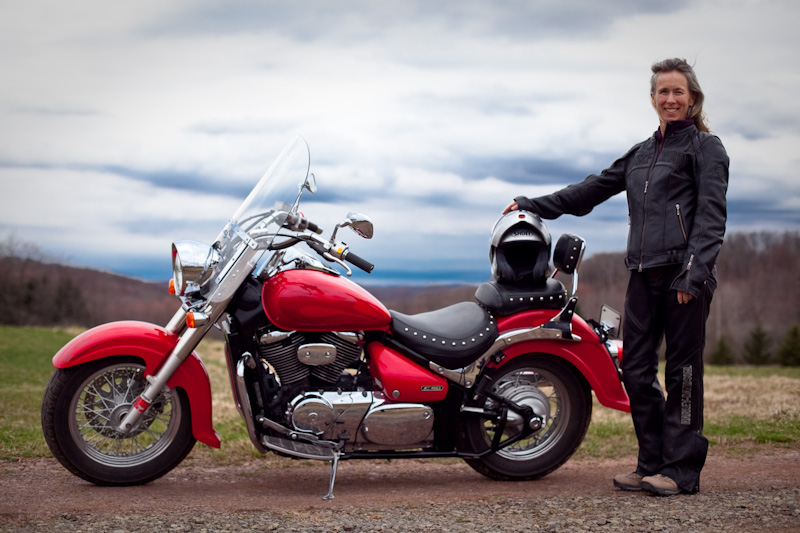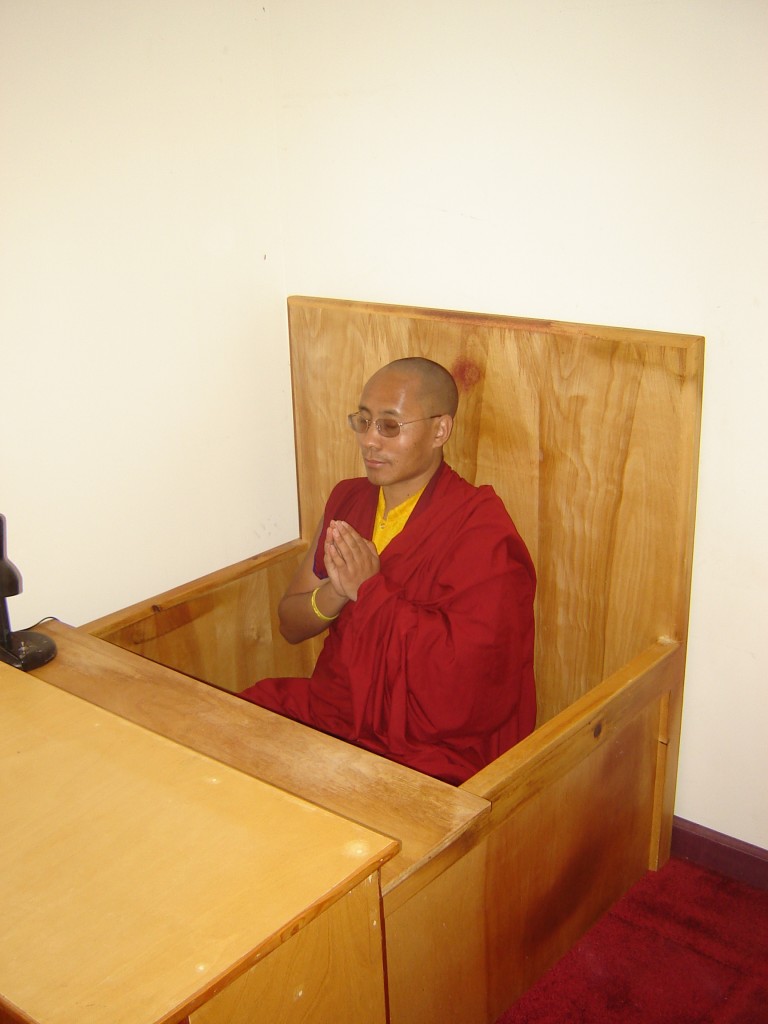Driving slower than the speed limit through the Village of Delhi (Pop. 3087) in upstate New York, I could see ahead, two monks sporting brightly colored monastic robes and walking placidly along Main Street. I piloted my motorcycle to the right and parked in an empty space. I switched the key off and turned to see smiling faces. One of the monks asked me, “Do you ride this bike?” I smiled at the silliness of his question as I stood there with a full-face helmet on my head. Sometimes others have a difficult time believing what they are seeing.
I stopped to talk with the monks because I am a correspondent for our local newspaper and cover religion. “Could I interview you?” I asked the men, after giving them my spiel about who I am and what I do.
“Oh yes, I’d be happy to speak with you,” said the Tibetan monk who introduced himself as Lama Karma Drodhul. We agreed to meet in a couple of hours at the Karme Ling Retreat Center on the outskirts of the Catskill Mountains.
A few hours later, after following Lama Karma’s driving directions, I found myself riding my bike up a long gravel road, surrounded by prayer flags held up by untiring tree limbs. I parked the bike in what I assumed to be a parking lot and walked one hundred feet down to the main building. I knocked on the door. No one answered. Fortunately, two everyday women came up to the house and told me, “Just walk right in, but be sure to take off your shoes.”
I obeyed.
The familiar face of one of the monks I’d met in Delhi came down the hall toward me. He reminded me of his name, Lama Karma Lodro before inviting me into his room—a room barely spacious enough to do a jumping-jack. I sat on a sleeping berth which was next to one wall in the corner. A 4-drawer dresser was up against a second wall and next to the third wall was a desk crowned with a laptop. The bed was hard and the fourth wall was nonexistent except for a book shelf serving as a makeshift barrier from what appeared to be a main hall to the communal kitchen. I noticed the dresser was laden with Buddha statues and other icons as Karma Lodro briefly explained the Karma Kagyu Lineage of Tibetan Buddhism taught and practiced at the Retreat Center.
The Kagyu Lineage has been headed by a succession of reincarnations of the Gyalwa Karmapa, a self-announced line, because each incarnation leaves a letter predicting his next rebirth. All great Kagyu teachers regard His Holiness Karmapa as the embodiment and source of all the blessings of the lineage. His Holiness the Gyalwa Karmapa the 17th teaches and inspires the lineage of the Kagyu order today, which is known for its meditative practices, its focus on retreat, and the many realized masters it has produced.
Striving to learn, while keeping the facts straight and clear, I barely noticed when Lama Karma appeared in the room. The interview seamlessly transferred away from Karma Lodro, to Lama Karma. I was told that the sole purpose of the Karmapa’s incarnation is to lead living beings from suffering into freedom, or the realization of mind’s deepest, pure nature. Then, as if it was perfectly natural, Lama Karma asked me, “Did you ride your motorcycle here?”
“Yes,” I replied, without looking up from the pad I was hastily writing notes on.
“Where is it parked,” Lama Karma asked.
“Up in the parking lot,” I answered.
“Let’s go up there,” he said, turning to walk away.
I scribbled a few more words while standing up and walking to the front door. Lama Karma slipped on his brown shoes and waited for me to stuff my pad and paper in my gray cotton bag, and then sit on the floor to pull on and lace my boots. I jumped up to follow Lama Karma.
Outside the house, we began walking up to the parking lot. He immediately embarked on interviewing me about riding and writing. Intent on reversing back to being the interviewer instead of interviewee, I ended with an answer immediately followed by a question. “Yes, I have driven the bike across the United States, on Highway 2. What are the goals of a Tibetan Buddhist?”
We reached the parking lot and Lama Karma remarked thoughtfully, “To overcome suffering and help others.” Wanting to broaden the uncomplicated answer, he pointed out that human beings too often associate suffering with physical problems—a mistake that doesn’t reach the real cause. A healthy lifestyle is important. But, “Suffering is caused by anger, attachment, greed, envy, and pride,” Lama Karma said. To know compassion and the willingness to help others is to know happiness. This knowledge is received through enlightenment, it is enlightenment, and “The full awakening is possible for every living being who sincerely engages in practice,” said Lama Karma.
There are many forms of practice. The Karme Ling Retreat is open to the public on Monday for sitting meditation. The Dewachen Columbarium building is open to Buddhists of all traditions. And, the Retreat building is utilized for extensive meditation, lessons, chanting, and music, lasting 3 years and 3 months. No talking. No cell phones. No TV.
In the case of an enlightened being, rebirths are taken consciously, motivated by a desire to benefit all living beings and made possible by the depth and clarity of an individual’s realization. “Inner peace is found, you become calm,” Lama Karma enumerated slowly. Interestingly, although Lama Karma’s language and forms of practice are different from mine, I felt a connection with his spirit of love and logic, very similar to what I’ve learned and experienced in my study of Christian Science. Then, my brain jolted as Lama Karma asked, “Will you take a picture of me on your bike, please?”
“Sure,” I answered, putting my pad and pen on the ground and taking a cell phone from Lama Karma after he showed me which button to push to capture the image of an orange robed monk sitting on a Suzuki C-50 motorcycle. He was going to post it on Facebook, because people sometimes only believe what they see.
After the photo-shoot, Lama Karma tussled to dismount the bike yet said, “I’d like to show you the Retreat building.” My back straightened as respect welled up inside me.
 The Retreat building is completely fenced in with a 10 foot tall wooden barrier. The secluded facility is used for the traditional 3-year Retreat program at Karme Ling, first established in the early 1990’s following the request of the 16th Karmapa, as a way of training serious practitioners in the core teachings and practices of the Karma Kagyu Lineage.
The Retreat building is completely fenced in with a 10 foot tall wooden barrier. The secluded facility is used for the traditional 3-year Retreat program at Karme Ling, first established in the early 1990’s following the request of the 16th Karmapa, as a way of training serious practitioners in the core teachings and practices of the Karma Kagyu Lineage.
The last retreat ended in March 2012 therefore the building was open and empty on the day I came to interview. Retreats begin on the 22nd day of the ninth Tibetan month. The sixth retreat training began September 7, 2012 at Karma Ling.
“I’ve completed 2 retreat programs,” explained Lama Karma, as we entered the isolated plot of land. I tried to walk softly across the ground so as not to disturb, What? Lama Karma wasn’t in the least bit disturbed. We entered the building and he pointed to a large room, carpeted with plushness and decorated extensively with Buddha icons. “This is the main meeting area where lessons and chanting and music occur,” he said. “All the retreat practices are done in the Tibetan language and there are no transliterated texts.”
We turned to walk down a long hallway dotted with doors. “These doors lead into private rooms. One per person,” said Lama Karma before taking me into one of the cubicle rooms where I found a window, a dresser, an offering platform, and a 4 foot square box, outlined with an approximately 20 inch high wooden partition. Lama Karma explained, “This is the meditation box. We pray and sleep in this box, while sitting upright the entire time,” explained Lama Karma as he stepped over and into the box and sat on the floor, crossing his legs in front of him as easily as I eat chocolate ice-cream.
“You sit all the time?” I asked, not wanting to tell him that the only way I can sleep is in a dark, quiet, cool room in a soft yet firm bed with lots of covers.
Repeating myself only in different words, I asked, “You never lay down flat?”
He smiled at the silliness of my question as he sat naturally in the box that precluded laying down. “We stay upright,” Karma underscored.
“Wow, you must be a pro at sleeping while traveling on airplanes,” I said.
“Yes, I am most peaceful when sitting,” said Karma.
I pulled my digital camera out of my gray bag and took a picture. Sometimes it is difficult to believe what I am seeing.
Lama Karma Drodhul travels extensively to teach Buddhism. “I travel between centers in North America, South America, Taiwan, and even make it back home to Tibet every now and then.” Tibet is Lama Karma’s birth land. His parents had 10 children and Lama Karma was destined to be a monk. At the age of nine years, Lama Karma received intermediate ordination, and again at the age of 20 years he received full ordination. Lama Karma excelled in all aspects of dharma study and completed his education in five years. He was then sent to the United States to deepen his understanding of the dharma under the tutelage of Khenpo Karthar Rinpoche. In March 2004, Lama Karma completed his first, and in February 2008 his second, traditional three-year, three-month retreat under Khenpo Karthar Rinpoche at Karme Ling Retreat Center. He now is the Drubpon (retreat master) at Karme Ling.
Karme Ling Retreat Center sits sheltered on 85 wooded acres. There are 6 buildings and 8 cabins suited for nomadic life. Buddhists on the site are vegetarian or vegan, but all strive to care for the environment and animals. “Enlightenment is difficult work, but rewarding when you start with a good seed of knowledge,” reflected Lama Karma. “No matter how hard you work, if you start with a bad seed, there is no potential. So, start with a good seed and you can achieve less suffering and happiness.”
After shaking hands with a hearty thanks and good-bye, Lama Karma then watched me don my helmet before swinging my leg over my bike seat and pushing the start button. I drove down the driveway, under prayer flags. I recalled Lama Karma saying, “Where the wind blows, the prayer goes.”

